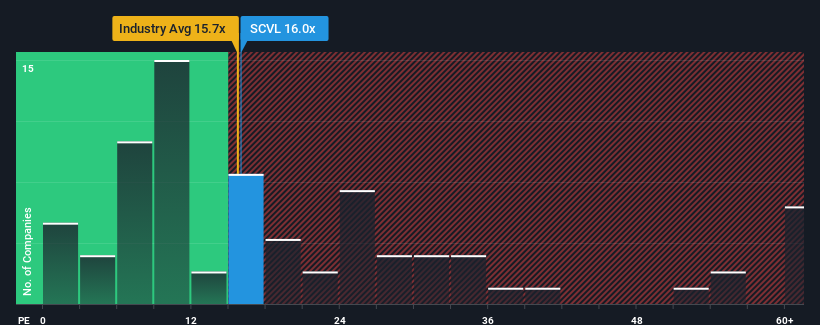- United States
- /
- Specialty Stores
- /
- NasdaqGS:SCVL
Shoe Carnival, Inc.'s (NASDAQ:SCVL) Earnings Are Not Doing Enough For Some Investors

Shoe Carnival, Inc.'s (NASDAQ:SCVL) price-to-earnings (or "P/E") ratio of 16x might make it look like a buy right now compared to the market in the United States, where around half of the companies have P/E ratios above 19x and even P/E's above 34x are quite common. Nonetheless, we'd need to dig a little deeper to determine if there is a rational basis for the reduced P/E.
With earnings that are retreating more than the market's of late, Shoe Carnival has been very sluggish. It seems that many are expecting the dismal earnings performance to persist, which has repressed the P/E. If you still like the company, you'd want its earnings trajectory to turn around before making any decisions. If not, then existing shareholders will probably struggle to get excited about the future direction of the share price.
See our latest analysis for Shoe Carnival

How Is Shoe Carnival's Growth Trending?
The only time you'd be truly comfortable seeing a P/E as low as Shoe Carnival's is when the company's growth is on track to lag the market.
Taking a look back first, the company's earnings per share growth last year wasn't something to get excited about as it posted a disappointing decline of 13%. As a result, earnings from three years ago have also fallen 27% overall. Accordingly, shareholders would have felt downbeat about the medium-term rates of earnings growth.
Shifting to the future, estimates from the two analysts covering the company suggest earnings should grow by 3.5% over the next year. Meanwhile, the rest of the market is forecast to expand by 15%, which is noticeably more attractive.
In light of this, it's understandable that Shoe Carnival's P/E sits below the majority of other companies. It seems most investors are expecting to see limited future growth and are only willing to pay a reduced amount for the stock.
The Key Takeaway
Using the price-to-earnings ratio alone to determine if you should sell your stock isn't sensible, however it can be a practical guide to the company's future prospects.
We've established that Shoe Carnival maintains its low P/E on the weakness of its forecast growth being lower than the wider market, as expected. At this stage investors feel the potential for an improvement in earnings isn't great enough to justify a higher P/E ratio. Unless these conditions improve, they will continue to form a barrier for the share price around these levels.
A lot of potential risks can sit within a company's balance sheet. Our free balance sheet analysis for Shoe Carnival with six simple checks will allow you to discover any risks that could be an issue.
If you're unsure about the strength of Shoe Carnival's business, why not explore our interactive list of stocks with solid business fundamentals for some other companies you may have missed.
New: Manage All Your Stock Portfolios in One Place
We've created the ultimate portfolio companion for stock investors, and it's free.
• Connect an unlimited number of Portfolios and see your total in one currency
• Be alerted to new Warning Signs or Risks via email or mobile
• Track the Fair Value of your stocks
Have feedback on this article? Concerned about the content? Get in touch with us directly. Alternatively, email editorial-team (at) simplywallst.com.
This article by Simply Wall St is general in nature. We provide commentary based on historical data and analyst forecasts only using an unbiased methodology and our articles are not intended to be financial advice. It does not constitute a recommendation to buy or sell any stock, and does not take account of your objectives, or your financial situation. We aim to bring you long-term focused analysis driven by fundamental data. Note that our analysis may not factor in the latest price-sensitive company announcements or qualitative material. Simply Wall St has no position in any stocks mentioned.
About NasdaqGS:SCVL
Shoe Carnival
Operates as a family footwear retailer in the United States.
Flawless balance sheet established dividend payer.
Similar Companies
Market Insights
Community Narratives



